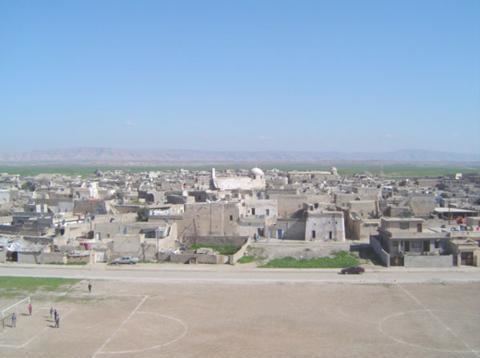Time zone GMT +3 | Governorate Ninawa Local time Wednesday 11:33 PM | |
 | ||
Weather 12°C, Wind N at 6 km/h, 81% Humidity | ||
Tesqopa (Tel Eskof or Tel Skuf or Tall Asqaf) (Syriac: ܬܠܐ ܙܩܝܦܐ; Arabic: تللسقف Tall Usquf 'Bishop's Hill') is an Assyrian town in northern Iraq located approximately 19 miles (about 28 kilometres) north of Mosul. In 2010, it had a population of 11,000 most of whom were Chaldeans belonging to the Chaldean Catholic Church. The town was captured by ISIS briefly in August 2014 and May 2016 but it is now partially reinhabited.
Contents
- Map of Telskuf Iraq
- The Origins of the Name
- History
- Modern Day Tesqopa
- Language and Culture
- Churches and Archeological sites
- Schools
- References
Map of Telskuf, Iraq
The Origins of the Name
The name Tesqopa is of Syriac origin "Tilla Zqeepa" meaning the "Standing Hill" in reference to the hill next to it that contains the ruins of an ancient town. The people of Tesqopa are called Tisqopnaye [tis-kohp-na-ey] (singular: Tisqopnaya) (Syriac: ܬܣܩܘܦܢܝܐ) (Arabic: تللسقوفي).
History
Tesqopa is not mentioned in Thomas of Marga's Book of Governors (c. 840) or any of the other early monastic histories of the Church of the East, and may well have been founded as late as the Seljuq period, perhaps in the eleventh century. It is first mentioned as an Assyrian Christian village in a thirteenth-century poem by the Assyrian writer Giwargis Warda. This poem describes its sack by a raiding band of Mongols in November 1235 and the destruction of its church of Mar Yaʿqob the Recluse.
Tesqopa was subject to many attacks by the Mongols, the worst among them was the massacre of 1436 when they attacked the town, killing thousands of its Assyrian inhabitants and burning its crops and churches, ultimately forcing the rest of the inhabitants to flee to the mountains. In 1508 Tesqopa was attacked again by the Mongols, just as they attacked Tel Keppe, Alqosh and the Monastery of Rabban Hormizd. Tesqopa was also attacked by the army of Nader Shah in 1743 during his march on Mosul.
Modern Day Tesqopa
The town received many Assyrian refugees from Baghdad and Mosul in the wake of the sectarian violence in the 2000s. On 23 April 2007 a car bomb that targeted the village resulted in more than 25 deaths.
In early August 2014, Islamic State of Iraq and Syria (ISIS), or Islamic State(IS), entered Tesqopa. But on 17 August 2014 the Kurdish Peshmerga retook Tesqopa. After this, the local Assyrians were then able to restore the crosses atop their vandalized churches. Some of the residents returned to the town, under the watch of Peshmerga and NPU, as the town was only 10 minutes from the ISIS ine.
ISIL militants overran the town during dawn on 3 May 2016 however they were driven out of the town by Peshmerga fighters later in the day. By 2017, several hundred families had returned to the town and the parish church was functioning again.
Language and Culture
The people of Tesqopa speak Neo-Aramaic as their first language; however, Arabic is their second language and is used in their schools.
Tesqopa used to be famous for its pottery which it provided to Mosul and its surroundings. This industry ended after Tesqopa children moved into more modern jobs. Aside from pottery, farming and raising cattle have always been the main source of income for the people of Tesqopa.
Churches and Archeological sites
Tesqopa has two churches: Mar Yacob's (St. Jacob's) Church, which was built during the 13th century and Mar Gewargis's (St. George's) Church, rebuilt in 1955. The most important archeological remains in Tesqopa are those east of town where Dayra d'Mar Aprim (St. Ephrem's Monastery) used to be. Currently, its location is used as the village's cemetery. Mar Aprim, who built this monastery, was a monk who lived during the tenth century. This monastery was rebuilt in 1403 with money from the people of Tel Keppe.
In the churches of Tesqopa are over 26 historical Syriac inscriptions. The oldest among them is dated 1698. Also, in the Museum of Berlin are kept three inscriptions written in Tesqopa during the 19th century. Moreover, in 1988 next to the hill of Tesqopa, the people of Tesqopa found a very old cave with some human remains and tools. An expedition was sent by the Iraqi government to explore the site, butt they did not publicize their findings.
Schools
In Tesqopa there is a Pre-school, two elementary schools (one for boys and one for girls), and a middle-high school. These schools provide the required education for students between the ages of 4 and 18.
